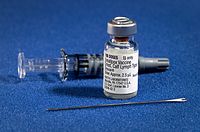
Photo from wikipedia
The purpose of this commentary is to describe the unique methodologic challenge of using real‐world data (RWD) and current coding systems to identify vaccine exposure at the brand level. Great… Click to show full abstract
The purpose of this commentary is to describe the unique methodologic challenge of using real‐world data (RWD) and current coding systems to identify vaccine exposure at the brand level. Great progress has been made in understanding real‐world evidence (RWE) and its potential to inform decision making, with the goal of attaining a learning health‐care system. Initial efforts have rightfully focused on generalities applicable to the full range of medical products and disease areas. As broader issues are defined and clarified, it becomes important to understand nuances that may be unique to a subgroup of medical products. Vaccines are an example of such a subgroup; in general, most principles of pharmacoepidemiology apply to vaccines; however, multiple characteristics (such as their use by healthy populations to prevent disease) distinguish pharmacoepidemiology of vaccines from other medical products. As in pharmacoepidemiology in general, ascertainment of exposure is critical when studying vaccines. Administration of a vaccine is a discrete event and relatively simple to document, compared with some drugs prescribed for use in outpatient settings and over varying time periods. However, vaccine exposure ascertainment through electronic health‐care records and/or administrative claims relies on coding systems that do not always distinguish between vaccine products at the brand level. This is in contrast to ascertainment of drug exposure, which may occur through prescribing and dispensing data, all of which specify unique product information. To accomplish the goal of integrating information from clinical care into public health decisions around vaccines, it is important to fully understand options for vaccine exposure ascertainment using real‐world data and the differences between vaccine exposure data collected in “traditional clinical trials” and the “real‐world.” In “traditional clinical trials” the investigator administers the treatment (the vaccine product) and has access to complete information about the treatment product, while in real‐world settings, information about vaccine administration is obtained
Journal Title: Pharmacoepidemiology and Drug Safety
Year Published: 2019
Link to full text (if available)
Share on Social Media: Sign Up to like & get
recommendations!